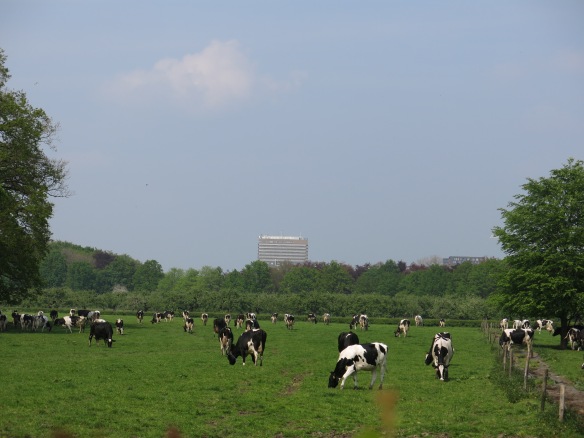
With one look my husband fell in love with Dutch…cows. “They look so happy!” Michael exclaimed on our first train trip through central Holland. I pointed out he probably meant they appeared to be well-fed and watered, and thus are probably physically “content,” because it’s really not possible for human’s to assess an animal’s “happiness,” especially from a whizzing train. But, being Michael, he refused to budge from his anthropomorphic assessment of hundreds of bovines’ mental state.
“Cows in Holland are happy cows.”
Drawing on lessons from Psych 101, I canned logical argument and attempted to draw out his “reasoning” with an encouraging “Uh-huh?”
“The cows here are happy, because the grass is so green, there’s water everywhere, their udders are huge – and they look so happy!”
I summoned my nominal bovine knowledge and replied, “Full udders mean they need to be milked and the cows are probably wishing for nothing more right now than to get back to the barn, get out of this damn rain, and get milked so their udders won’t be so painful.” He, of course, ignored me.
And so he began calling the rain-soaked, canal-ringed-and-riddled, mostly-below-sea level Netherlands (italics are a clue, folks) “The Land of Happy Cows.”
So much for psychology.
To exacerbate my annoyance with such anthropomorphism, Michael began to “document” why Dutch cows look happy. He claims several people told him (I’ve not met one) the Dutch had passed laws years ago that restricted the amount of time cows could be kept penned within barns. In other words, lots of rain, fresh air, lush grass, and water produce healthier cows, which results (theoretically) in a higher quality of milk from which the fabulous Dutch cheese is made. And, as Michael insists: “happy cows.”
Mind you, Michael is New York City born and bred and just because he learned to fix a tractor and ride a horse does not necessarily make him a Bovine Authority.
Being the curious sort, I finally got around to doing an internet search on Dutch laws concerning cows’ rights to stand out in the rain all day chewing their cuds. I found general laws on livestock husbandry, but nothing to indicate that the Dutch have embraced bovine grazing rights as banner legislation. In fact, I found the exact opposite: according to two 2013 reports, grazing among dairy cows is rapidly decreasing in Western Europe, including the Netherlands.
So — where’s the cow?
Cows are everywhere in Holland. You find them in the darnedest places.
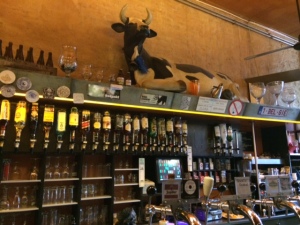
The Bar Cow at Cafe Belgie
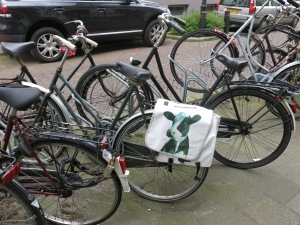
Trust the Dutch to decorate their bikes with cow pix.
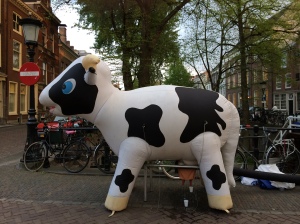
And if you can’t find cows in the middle of Utrecht, you can bring along your own inflatable cow.
First, a bit of History of the Dutch Dairy Cow. All those cud-chewing, udderly fat cows that Michael claims are so happy are all Holstein-Friesian cows, usually called Holsteins, the hands-down best milk-producing bovines on the planet. And, of course, these cows developed in…Friesland, in northern Netherlands! Early Dutch settlers brought some Holsteins with them in the 1600’s when they settled in New Amsterdam (currently New York City) and upstate New York. As other colonists discovered the attributes of the breed in milk production, additional Holsteins were imported. By the late 19th c., the Holstein became the foundation of U.S. dairy production.
These black and white cows initially were bred to thrive on the native grasses of northern Netherlands, but on modern dairy farms, their diet is no longer exclusively grass. They are given feed supplements of both grain and dried grasses (hay), especially in the winter months.
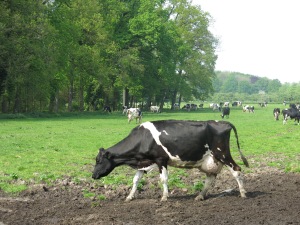
A typical Holstein cow.
The Dutch Dairy Board website is chock-full of fascinating information about the dairy industry, including their “thematic goal” of maintaining grazing “at least at its current levels.” Having cows graze 6 hours per day, 120 days per year seems to be part of the “grazing goal.” However, while they note that 73.6% of dairy cows meet this “grazing goal,” 18.8% never graze at all, and the remaining 7.7% have an unspecified, “other type” of grazing.
What the Dutch do seem to regulate quite well are the limitation of unnecessary antibiotics, prohibition of hormones to increase milk production, the types of minerals (e.g. fertilizers, and other grass “enhancers”) put into the soil, veterinary “treatments,” as well as milk processing from milking to end dairy product – all good activities for consumer, bovine and environmental well-being.
So, in answer to the question heading this paragraph, nearly three-fourths of Dutch Holstein cows of today spend a lot of time standing in pastures during the months of April to November. They don’t seem to mind the rain, which is a good attribute, and despite the time of day, their udders always look full-to-bursting from all that lush, rain-soaked grass.
For a cute but short video of happy-looking cows being released from their barn in springtime, go to https://www.youtube.com/watch?v=rDvnUiO-LAk.
But as noted by the Dutch Dairy Board, this picturesque pastoral scene of contentedly grazing cows is rapidly changing. The small-holder dairy farms are facing increasing economic pressures and competition from larger “franchises,” and many solo farmers have been swallowed by these milk-production conglomerates.
So, Michael, enjoy your “happy” cows. For the foreseeable future we can both continue to call the Netherlands “The Land of Happy Cows,” and toast these joyous bovines who produce such good cheese.
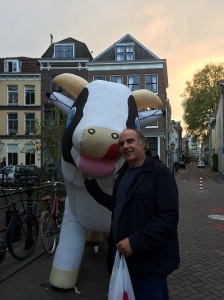
Some Peripheral Information on Dairy Cows
If you’re sick of reading about cows and dairy production, skip “Dairy Facts” and go straight to “Famous Cows.” The latter is amusing, I guarantee it.
Dairy Facts:
I know I get carried away in researching my blogs, but some of what I found out about the dairy industry, particularly in Holland, is interesting:
- According to a 2013 report by the Dutch Dairy Board, “Dairy is the engine of the Dutch economy.”
- There are 18,500 dairy farms and 1.97 million dairy cows in the Netherlands which produce 12 billion kilos of milk annually (about 26.45 billion pounds).
- 56% of Dutch dairy products is cheese.
- Dairy products accounts for 9% of the Dutch economy’s trade surplus.
And in the U.S.:
- The World Dairy Expo is the international trade organization for dairy cows is held annually in Madison, Wisconsin. It’s the largest dairy trade show in the world, but features dairy cattle from the U.S. and Canada.
- Black and white Holsteins (there is a recessive line of red and whites) have won “Supreme Champion” honors at the World Dairy Expo 32 times in the last 42 years, far more than any other breed of dairy cow.
- There are over 9 million dairy cows in the U.S., and 90% of them are of Holstein descent.
Famous Cows: (This is why blogs were invented….)
- A Canadian Holstein named Missy is the most expensive cow in the world, bringing $1.2 million in after being named “Supreme Cow” at the World Dairy Expo in 2011.
- A Holstein cow named “Ever-Green-View My 1326-ET” (no lie) won the world record for milk production in 2010 by producing over 72,000 pounds of milk in one year. The average Holstein produces 23,000 pounds of milk per year. Of note, “Ever-Green” is a Wisconsin cow.
- President William Howard Taft had not one – but TWO – pet cows at the White House. When the first official “Presidential Cow” Mooley Wooly died, Senator Isaac Stephenson of Wisconsin donated “Miss Pauline Wayne,” a Holstein from his farm. “Miss Wayne” served as “First Cow” for three years. She became popular at dairy trade shows where her milk, in miniature bottles, was sold as a novelty for 50 cents. (Talk about a cash cow…) When Taft left office, “Miss Wayne” was returned to Stephenson’s farm.
- “Miss Wayne” narrowly missed an ignominious death in 1911. She was returning from an appearance at a dairy show when her private train car was accidentally attached at a rail switch to a train of cattle cars found for the Chicago slaughter houses. Telegrams were sent throughout the land and a group of cow-loving vigilantes saved Miss Wayne. Apparently, they had a tough time convincing the stockyard that they were about to slaughter the President’s pet cow.
![]()

Carol Barbier Rolnick grew up in Japan and Southeast Asia, traveling extensively as a child through Asia, the Mideast and Europe on family vacations. Travel has continued as a priority through raising kids and continuing into retirement, extending adventures through the Americas, southern Africa, Asia, and repeat trips throughout Europe. Carol and her husband, Michael spent four summers based in Utrecht, The Netherlands, which has become like a second home. They are (still) aiming towards Australia-New Zealand and Antarctica to round off their continental travels.








